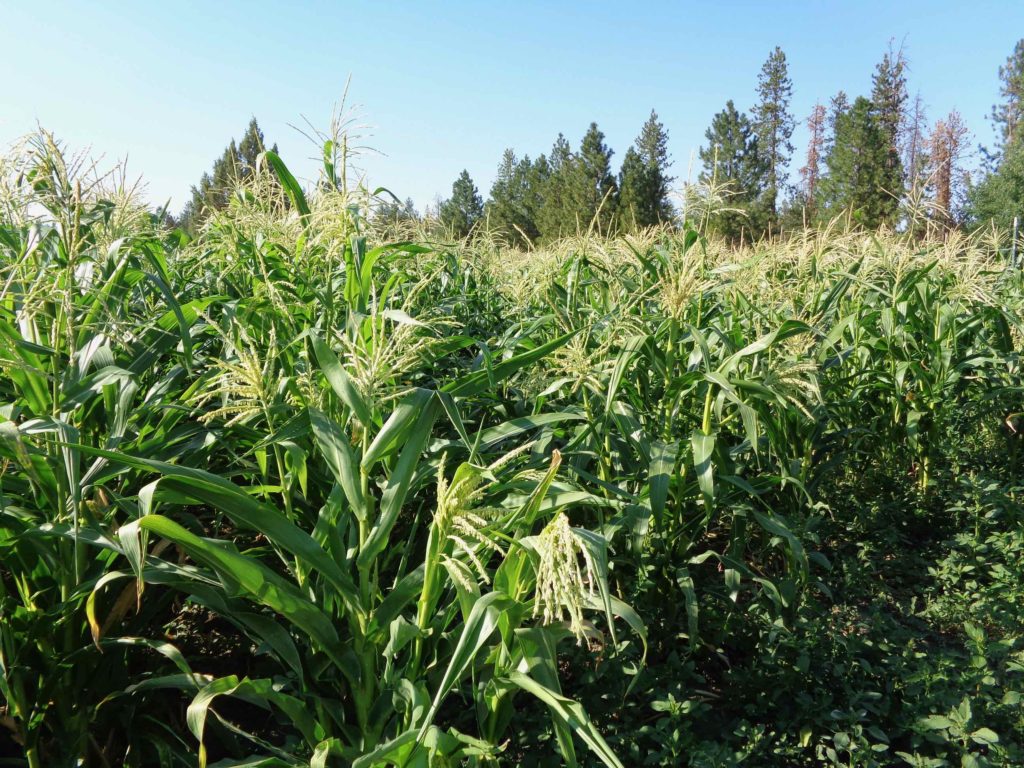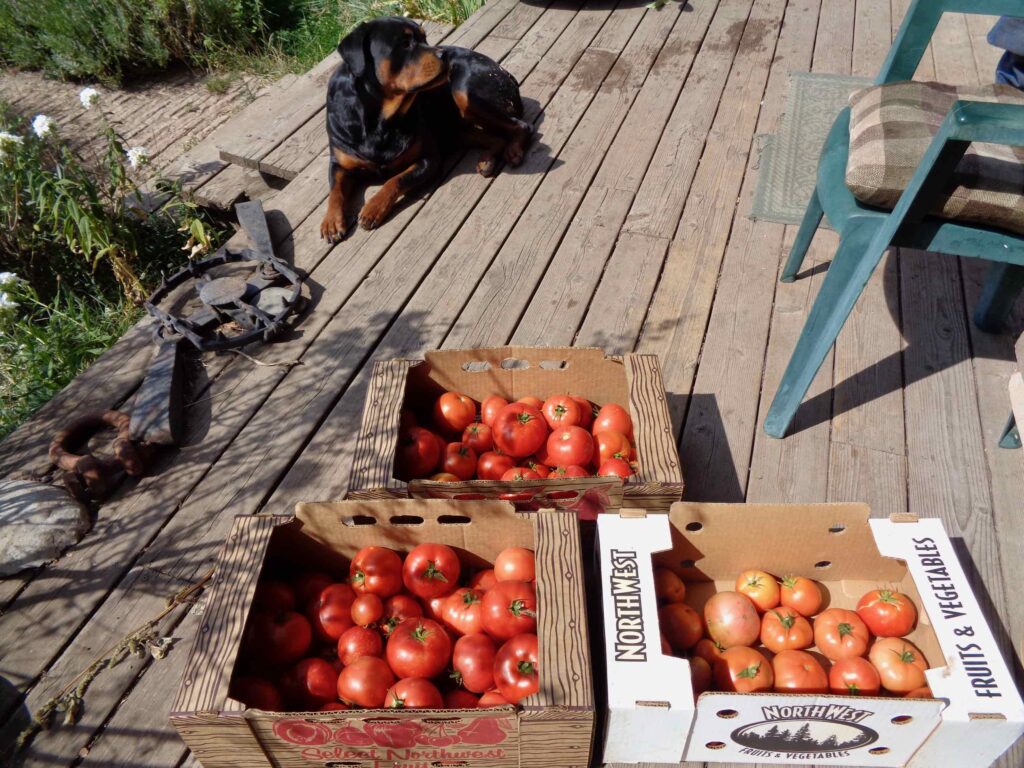10.2.22
October is here. The past fortnight or so, despite daytime temperatures creeping up near 90 degrees, the mornings have had a briskness to them that is a harbinger winter is not far off. These crisp mornings where one is inclined to pull a wooly jumper on and one’s mind looks forward to lighting a fire in the old wood cookstove, create a sense, almost an urgency inside, to bring the harvesting home.
The past few weeks that sense of urgency to prepare for the coming winter has been upon Darrell and me, as happens almost every year. This year for some reason, despite the hot days, the filling of our woodsheds with chunks of pine and juniper, the hauling in of the last of the hay supply for the animals, the harvesting of the garden, seemed especially rewarding to us. Each year Darrell harvests trees that have been killed by the infestation of pine beetles that plague our area. Piling the logs in our turnaround where they sit for another full year to dry before being bucked up into perfectly sized rounds that are then split into usable sized chunks and stacked in our woodsheds. There really is something incredibly satisfying about a full woodshed, especially since we heat and do most of our cooking with wood when the weather starts to cool.
The garden was, shall we say, a bit of a challenge this year. Darrell’s new potato patch, a chunk of virgin ground that has only ever had grass growing on it, turned out to be lacking in the nutrients the potatoes needed but gave the harvested tubers a spotty appearance! He was still able to harvest a fair amount of good tubers that will see us through the winter, but it was a bit of a disappointing harvest. The corn patch flourished and was lush and full of beautiful ripening ears. It looked as if we were going to get a bumper crop of corn to can, freeze and give the excess away, well, until the Redwing Blackbirds arrived!
These birds with their unmistakable trilling song, come to visit Darrell’s corn patch every year. It is as if they know they can get some good meals before they head off on their migration to the south. Normally, a flock of 25 to 30 birds arrives well after the main harvest of corn has taken place and we do not begrudge them their share. Their arrival, just as the flying over of the Sandhill Cranes, we take as a signal winter weather will not be too far off. However, this year we heard the cranes a tad bit earlier than normal and the blackbirds arrived very early indeed! One morning the trilling of a few birds was heard. A small flock of about 20 arrived and with sentries posted here and there on some of the taller corn stalks, their companions seeked out the just ripened ears down below. We did not think too much of it, after all, there was a bumper crop this year. We had already started harvesting and enjoying the first sweet corn of the season and had shared some with friends. There was time to pick more for canning and freezing.

Within less than a week, the daily morning influx of the blackbird flock grew from a manageable 20 or so to suddenly 50, 100 then even more! Individual family flocks stealthily descended on the corn patch like squadrons of fighter planes coming in for a landing. A sentry bird or two kept on watch while the hoard disappeared in the thick foliage below, only their incessant chattering giving an indication of how many were feasting away – notice how I went from saying “trilling song” to “incessant chattering”? As we went to pick corn for dinner, the devastation became apparent. Those wily birds were experts at choosing the ripest, juiciest, plumpest cobs to feast on. Not content with pecking away at a single ear and eating the entire cob, they hopped from corn stalk to corn stalk, tearing and ripping down the silken tops, eating and destroying the uppermost part of ear after juicy ear throughout the patch. Within a few days they more or less destroyed Darrell’s lovingly tended corn. Resigning ourselves to the fact we would not be putting up corn this year, we watched as the word spread among the RWBA – Redwing Blackbird Association – that a tasty free feast was up for grabs at the Triple H Homestead farm. Flock after flock descended until there must have been well over a couple of hundred. Then just as suddenly as they arrived, they have almost all departed. Wonder what next year will bring… “Four and twenty blackbirds…”?
Anyway, they had their feast, and most have moved on. Thankfully they do not like cabbages or Brussel sprouts, all of which are doing wonderfully this year. I must say, one thing I can grow is Brussels and cabbage! One of my cabbages weighed in at 25 pounds and is now fermenting nicely in the sauerkraut tub. There are still some good cabbages out there that will be harvested and stored for this coming winter’s munching. The carrots stay in the ground but soon the onions will be ready for pulling and drying. Tomatoes have been picked and put up to enhance winter soups and stews, soon a couple more pigs will reside in the freezer and today, if it is to be, a deer will hang in the cooler to augment our winter meat supply. For yes, hunting season has begun.

Along with what we raise in both the vegetable and meat department, we do enjoy our venison and appreciate the challenge of harvesting a deer. As I sit here writing away this morning, the sky begins to lighten and soon I will be heading out with my rifle. We have a saying here, “you cannot eat the antlers”, so for us it is not about getting the largest buck with the biggest set of antlers, rather it is about harvesting an animal swiftly and cleanly. For years and years Darrell and I have adhered to the rule, if we cannot shoot it in the head or neck, thereby ensuring a quick, humane dispatch, we do not take the shot. Before I retired from cutting other people’s wild game, I saw too many animals shot multiple times just so a nice set of antlers could hang on the wall. To each their own of course, but we harvest for the good, healthy meat and hate to waste a scrap of it!
Yes, it is that time of year. A time when the primitive person inside us yearns to have a well-stocked pantry, a woodshed brimming with wood, a barn full of fodder for the animals we raise and most of all, the joy of pulling on a nice warm jumper of a chilly morning.